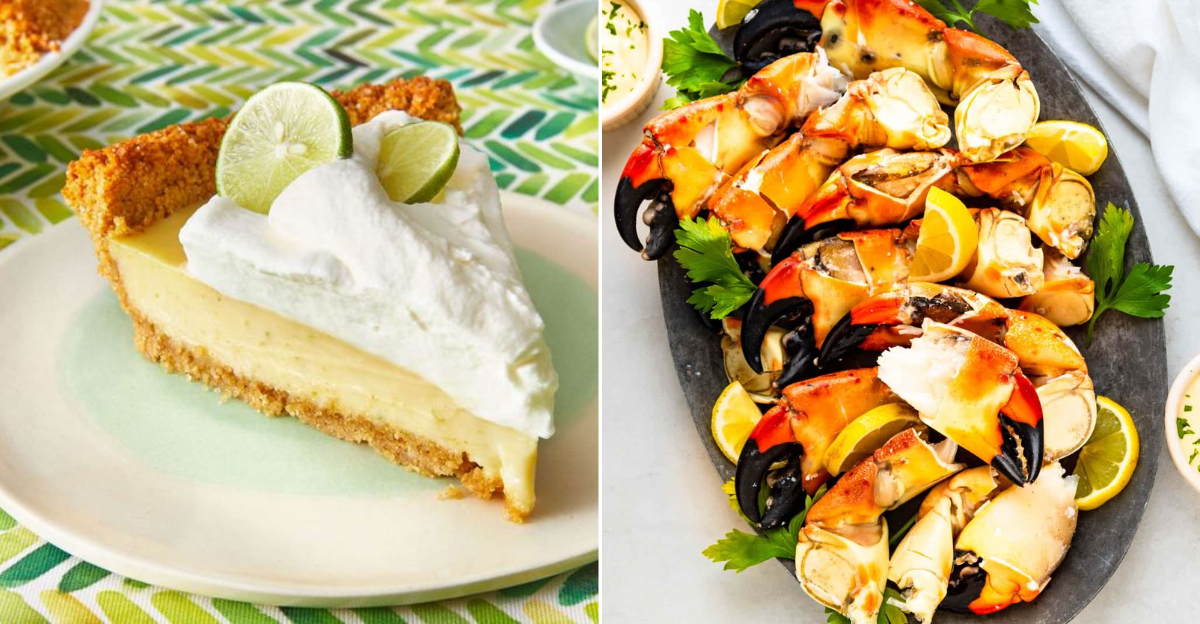16 Unique Florida Dishes You Won’t Find Anywhere Else

You can’t really understand Florida until you’ve tasted it. Every corner of the state has its own flavor—from the citrus groves and beachside grills to Cuban cafés and swamp-side fryers.
It’s a melting pot of cultures and coastlines, where seafood is king and bold seasonings are the norm.
Whether you grew up on gator tail or just visit for the key lime pie, these dishes capture the real Florida—sunny, surprising, and totally unforgettable.
1. Conch Fritters: Caribbean-Inspired Bites
Golden-brown spheres of fried goodness, conch fritters capture the essence of Florida’s Caribbean connections. These savory treats feature diced queen conch meat (pronounced “konk”) mixed with peppers, onions, and spices before being battered and deep-fried to perfection.
Originally from the Bahamas, conch fritters found their way to Key West and quickly became a staple throughout Florida. The chewy texture of conch contrasts beautifully with the crispy exterior.
Locals typically enjoy them dipped in a spicy key lime aioli or hot sauce. Though overfishing has made fresh conch harder to find, Florida restaurants maintain this tradition with imported conch or even sustainable alternatives.
2. Cuban Sandwich: The Iconic Tampa-Miami Rivalry
Few sandwiches spark debate like the Cuban, with Tampa and Miami each claiming ownership of the “authentic” version. The foundation remains consistent: crusty Cuban bread, roast pork, ham, Swiss cheese, pickles, and mustard – all pressed until gloriously crispy outside and melty inside.
Tampa’s version, influenced by Italian immigrants, controversially adds salami. Miami purists consider this heresy. The sandwich originated with Cuban tobacco workers in Florida during the late 1800s, seeking a filling lunch that wouldn’t spoil in the heat.
Regardless of which camp you side with, finding a proper Cuban sandwich requires seeking out family-owned establishments where the art of perfect pressing has been passed down for generations.
3. Key Lime Pie: Florida’s Tangy Treasure
Sunshine-yellow and bracingly tart, authentic Key Lime Pie bears little resemblance to the neon-green imposters found elsewhere. The magic happens when tiny Key limes, native to the Florida Keys, blend with sweetened condensed milk and egg yolks.
Traditionally baked in a graham cracker crust and topped with whipped cream, this dessert was invented by Florida Keys fishermen who needed treats that wouldn’t spoil without refrigeration. The condensed milk and acidic lime juice naturally thicken without baking.
State law even declared it Florida’s official pie in 2006! True connoisseurs know the genuine article by its pale yellow color – never green – and perfect balance of sweet and tart.
4. Publix Sub: Florida’s Beloved Supermarket Sandwich
Affectionately dubbed the “Pub Sub,” this supermarket sandwich has achieved cult status among Floridians. What elevates a Publix deli counter sandwich to legendary status? Many credit the pillowy-soft, freshly baked bread that’s crusty outside yet cloud-like inside.
The most famous variation, the Italian, layers Boar’s Head meats and cheeses with the signature “Publix touch” – a methodical arrangement where each ingredient is evenly distributed. Hurricane preparation in Florida famously includes securing a Pub Sub before stores sell out.
College students away from Florida often list Pub Subs among the things they miss most from home. This humble sandwich transcends its grocery store origins to become a true state icon.
5. Stone Crab Claws: Sustainable Seafood Delicacy
Harvested only for their regenerating claws, stone crabs represent Florida’s commitment to sustainable seafood. Fishermen carefully remove one claw and return the live crab to the water, where it will grow a new claw within a year.
The season runs strictly from October 15 to May 15, making these prized claws a special seasonal treat. Typically served chilled with a mustard dipping sauce, the meat is sweet, tender and reminiscent of lobster.
Joe’s Stone Crab in Miami Beach pioneered their popularity in the early 1900s. The firm, white flesh requires a special cracker to access – but locals know the effort is absolutely worth the reward.
6. Florida Orange Juice: Liquid Sunshine in a Glass
Morning rituals across America include Florida’s most famous export – but nothing compares to fresh-squeezed juice from oranges picked at peak ripeness. Florida’s unique growing conditions – sandy soil, abundant rainfall, and humid climate – create oranges with the perfect balance of sweetness and acidity.
Valencia oranges, Florida’s juice orange of choice, contain more juice and flavor than their California counterparts. The state’s citrus industry dates back to the 1500s when Spanish explorers planted the first trees.
Though facing challenges from citrus greening disease, Florida’s orange groves remain iconic. Roadside stands offering cups of just-squeezed juice provide travelers an authentic taste of Florida sunshine.
7. Deviled Crabs: Tampa’s Cigar City Creation
Shaped like footballs and packed with spicy crab filling, deviled crabs emerged from Tampa’s Ybor City neighborhood during the cigar-rolling heyday of the early 1900s. Cuban women created these portable meals for workers using local blue crab mixed with Cuban bread crumbs, peppers, onions, and spices.
The mixture gets breaded, deep-fried, and traditionally served with a wooden stick – a nod to their street food origins. While once sold from carts outside cigar factories, today they’re treasured at Tampa’s historic eateries and family gatherings.
The name “deviled” refers to the spicy cayenne kick in the filling. Despite their humble beginnings, these croquettes represent the perfect marriage of Cuban cooking techniques and Florida’s abundant seafood.
8. Gator Tail: The Ultimate Florida Experience
Nothing says “Florida” quite like eating the state’s most famous reptile. Alligator tail meat – typically marinated, breaded, and deep-fried – offers a mild flavor often described as a chicken-fish hybrid with a firm, distinctive texture.
Harvested sustainably through controlled hunting programs, gator meat appears on menus throughout the state. Old-school roadside establishments serve it with various dipping sauces, though remoulade remains the classic pairing.
Beyond the novelty factor, alligator meat is surprisingly nutritious – high in protein and low in fat. While tourists order it for the story, many Floridians genuinely enjoy this regional protein that their grandparents relied on during leaner times in the state’s history.
9. Minorcan Clam Chowder: St. Augustine’s Spicy Sensation
Ruby-red and fiery hot, Minorcan clam chowder bears little resemblance to its creamy New England cousin. The secret ingredient? The datil pepper – a small, extremely hot chili brought to St. Augustine by Minorcan settlers in the 1700s and grown there ever since.
This tomato-based chowder combines fresh local clams with bacon, potatoes, onions, and the distinctive pepper heat that builds slowly with each spoonful. Unlike other regional chowders, it’s uniquely Floridian, found primarily in St. Augustine and surrounding areas.
Family recipes are guarded jealously and passed through generations. The best versions maintain a delicate balance where the datil pepper’s heat complements rather than overwhelms the sweet brininess of the clams.
10. Spiny Florida Lobster: The Caribbean Crustacean
Unlike their Maine counterparts, Florida’s spiny lobsters lack the signature front claws but compensate with sweeter, more tender tail meat. These tropical crustaceans inhabit the warm waters from the Keys through the Caribbean, drawing thousands of recreational divers during the annual two-day sport season known as “mini-season.”
The most popular preparation keeps it simple – split, grilled with butter, garlic, and key lime. Their distinctive spotted shell and long antennae make them instantly recognizable to seafood enthusiasts.
Commercial harvesting is strictly regulated to protect the population. Locals celebrate these delicacies at annual festivals, where traditional preparations highlight the clean, delicate flavor that pairs perfectly with Florida’s tropical setting.
11. Grits and Grunts: Old Florida Breakfast
Before tourism transformed Florida’s economy, fishing villages along the coast relied on humble, satisfying meals like grits and grunts. The curious name comes from the sound these small fish make when caught – a grunting noise that earned them their nickname.
White, stone-ground grits provide the creamy base, while the small, sweet fish are typically pan-fried until crispy. Some traditional recipes include a light gravy made from the fish drippings.
This breakfast sustained generations of Florida fishermen before heading out to sea. Though harder to find on modern menus, several historic restaurants in fishing communities like Apalachicola and Cedar Key still serve this authentic taste of old Florida.
12. Grouper Sandwich: Gulf Coast’s Prized Catch
Massive in size and mild in flavor, the grouper sandwich reigns supreme along Florida’s Gulf Coast. The ideal version features a generous fillet of freshly caught black or red grouper – never frozen – lightly breaded or blackened, then served on a soft bun with minimal toppings to let the fish shine.
Tartar sauce, lettuce, tomato, and a squeeze of lemon complete this masterpiece. Beachside restaurants from Pensacola to Naples compete for the title of best grouper sandwich, with locals passionately defending their favorites.
Sadly, grouper’s popularity has led to menu fraud, with less expensive fish substituted. True Florida seafood experts can spot the difference immediately in both texture and flavor.
13. Kumquats: Citrus Jewels of Central Florida
Tiny orange orbs no bigger than olives, kumquats offer a surprising taste experience – sweet edible skin surrounding tart flesh, meant to be eaten whole. The town of Dade City celebrates these diminutive fruits with an annual festival honoring their unique place in Florida’s agricultural landscape.
Unlike other citrus, kumquats thrive in Central Florida’s occasional cold snaps. Their concentrated flavor makes them perfect for marmalades, preserves, and candying, while creative chefs incorporate them into sauces for fish and poultry.
Florida’s kumquat growers proudly ship these specialty fruits nationwide during their winter season. The name derives from Cantonese words meaning “golden orange,” perfectly capturing their jewel-like appearance.
14. Rock Shrimp: Florida’s Mini Lobster
Armored in hard shells that once made them commercial fishing discards, rock shrimp emerged as culinary treasures thanks to a specialized splitting machine invented in the 1970s. Found in deep Atlantic waters off Florida’s east coast, these crustaceans have firm, sweet meat often compared to lobster.
The town of Titusville proudly claims the title “Rock Shrimp Capital of the World.” Traditional preparation keeps it simple – split, brushed with butter and broiled – letting the natural sweetness shine.
Unlike their soft-shelled cousins, rock shrimp maintain their texture when cooked, making them perfect for pasta dishes and seafood boils. Their relatively recent rise to popularity represents Florida’s continuing evolution of seafood traditions.
15. Boiled Peanuts: Roadside Snack Sensation
Soft, salty, and utterly addictive, boiled peanuts bear little resemblance to their roasted counterparts. Green peanuts (raw, fresh-from-the-ground legumes) simmer for hours in heavily salted water, often with additions like cajun spices or ham hocks for extra flavor.
Roadside stands throughout North Florida and the Panhandle advertise them with hand-painted signs, serving this Southern delicacy in styrofoam cups or paper bags. The texture surprises first-timers – soft and bean-like rather than crunchy.
Florida officially named boiled peanuts the state snack in 2006. True enthusiasts keep a special container in their car for shells and know exactly which gas stations along rural highways serve the freshest batch.
16. Mickey-Shaped Treats: Disney’s Edible Icons
Transforming ordinary foods into Mickey’s iconic silhouette has become a culinary art form unique to Florida’s Disney parks. The classic Mickey waffle – with its perfect ear-to-face ratio – started the phenomenon, but now everything from ice cream bars to pretzels and macarons receives the three-circle treatment.
These treats combine nostalgia with genuine quality. The premium Mickey ice cream bar, for example, features Nestlé chocolate coating real vanilla ice cream – a recipe unchanged for decades.
Park veterans know to seek out seasonal variations, like pumpkin-spiced Mickey waffles in fall or red velvet Mickey cake pops for Valentine’s Day. These magical morsels have become so iconic that Disney sells Mickey-shaped waffle makers for home use.
